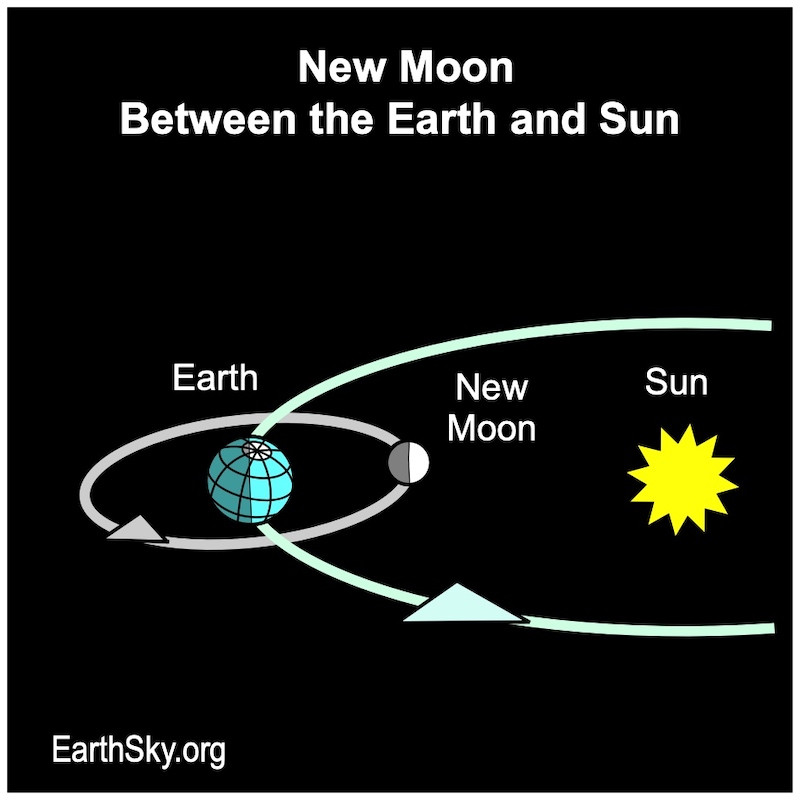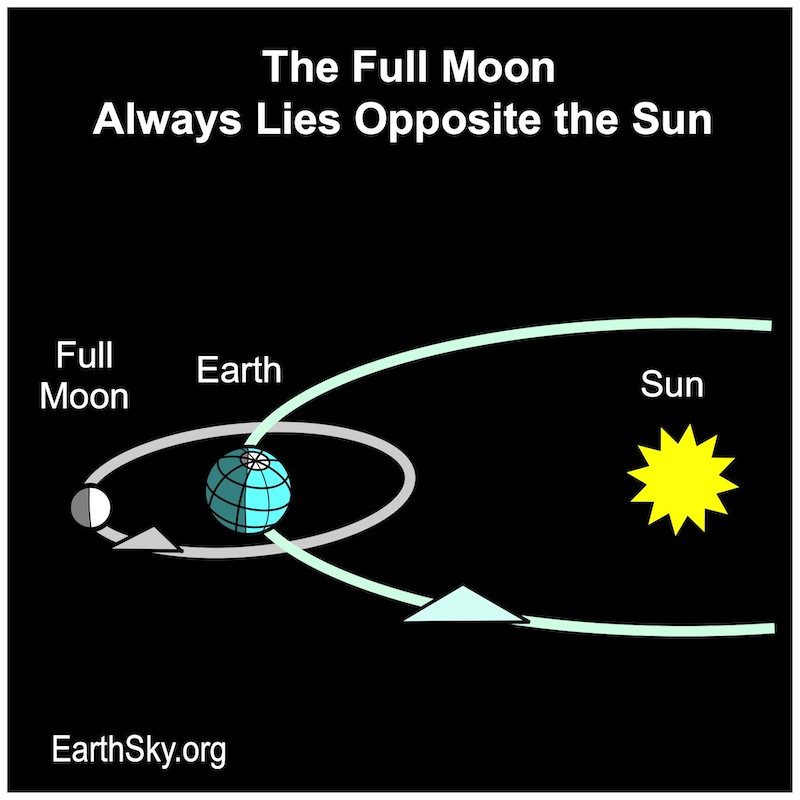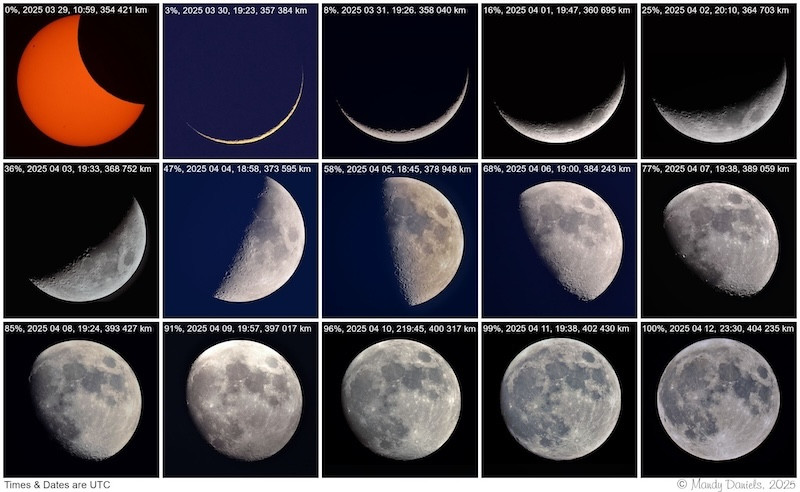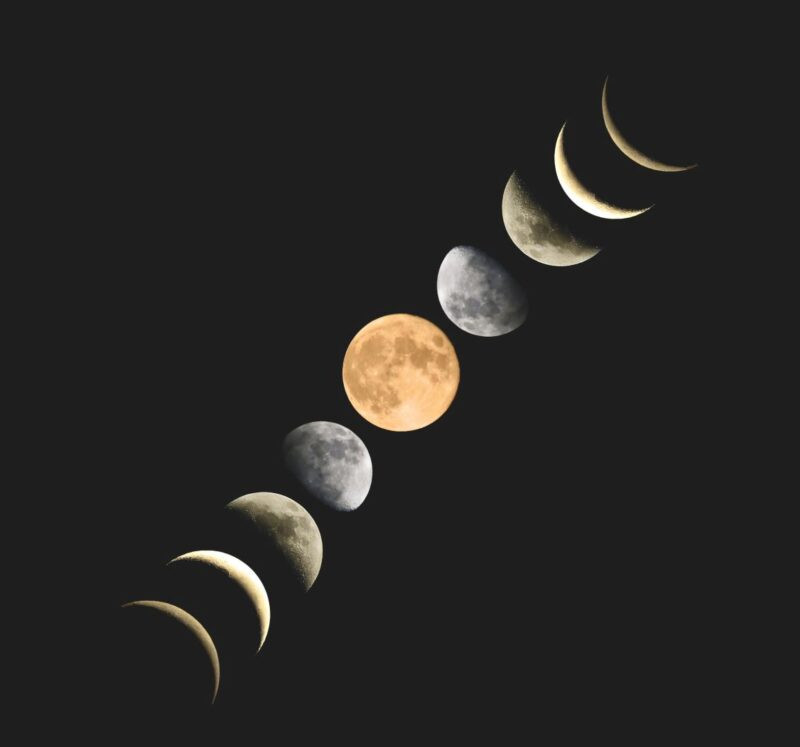Are you curious about the moon’s journey across the sky and planning a trip to Vietnam? The moon’s path is a fascinating dance, and SIXT.VN is here to help you navigate not only the lunar movements but also your travel needs in Vietnam. Our comprehensive travel services ensure a smooth and enriching experience, from airport transfers to hotel bookings and guided tours. Discover the moon’s secrets and Vietnam’s beauty with us. Consider SIXT.VN for a hassle-free travel experience, including reliable airport transfers, comfortable hotel accommodations, and captivating tours across Vietnam.
1. Understanding the Moon’s Orbit and Phases
The moon’s phases change daily because it orbits Earth, revealing different amounts of its sunlit surface. Like Earth, half of the moon is always illuminated by the sun, creating a day and night side. As the moon orbits Earth each month, we see different fractions of its illuminated side, leading to the various moon phases we observe.
To understand moon phases, consider these key points:
- The sun’s position: The sun illuminates the moon, creating its day side. Moon phases depend on the moon’s position relative to the sun in space.
- Rising and setting: The moon rises in the east and sets in the west daily due to Earth’s rotation. A crescent moon seen in the west after sunset is a setting moon, having risen earlier in the day.
- Orbital period: The moon takes about a month to orbit Earth, moving across the sky each day due to its orbital motion.
- Eastward movement: The moon’s orbital motion is eastward, moving approximately 12 to 13 degrees eastward on the sky’s dome daily. This causes the moon to rise about 50 minutes later each day.
1.1 Moon Phases Explained
Understanding moon phases is crucial for planning nighttime activities during your Vietnam trip. You can align your itinerary with full moon festivals or enjoy stargazing during new moon nights.
 28-panel composite with a moon in each panel varying in phase through a lunar cycle.
28-panel composite with a moon in each panel varying in phase through a lunar cycle.
- New Moon: The moon is between Earth and the sun, with its night side facing us, making it invisible.
- Waxing Crescent: A sliver of the moon becomes visible as it moves away from the sun.
- First Quarter: Half of the moon is illuminated.
- Waxing Gibbous: More than half of the moon is illuminated.
- Full Moon: The sun, Earth, and moon align, with Earth in the middle, fully illuminating the moon.
- Waning Gibbous: The illuminated portion decreases after the full moon.
- Last Quarter: Half of the moon is illuminated again.
- Waning Crescent: The illuminated sliver decreases until the new moon.
1.2 How the Moon’s Position Affects Tides in Vietnam
The moon’s gravitational pull primarily causes tides. When the moon is in line with the Earth and the sun (during new and full moons), the gravitational forces combine to create higher high tides and lower low tides, known as spring tides. Conversely, when the moon is at a right angle to the Earth and the sun (during the first and third quarter moons), the gravitational forces partially cancel each other out, resulting in lower high tides and higher low tides, known as neap tides.
Understanding these tidal patterns is beneficial for planning coastal activities in Vietnam, such as boat tours or beach visits.
2. The Apparent Movement of the Moon Across the Sky
The moon appears to move across the sky due to two primary factors: Earth’s rotation and the moon’s orbit around Earth. Earth’s rotation causes the moon to rise in the east and set in the west, similar to the sun and stars. The moon’s orbit around Earth also contributes to its apparent movement. Over the course of about a month, the moon completes one orbit around Earth, causing it to appear in different positions in the sky each night.
2.1 The Moon Rises in the East and Sets in the West
Just like the sun, the moon rises in the east and sets in the west. This is a consequence of Earth’s rotation. As Earth spins on its axis, celestial objects appear to move across the sky. Therefore, when you observe a thin crescent moon in the west after sunset, it is setting rather than rising. The moon had already risen earlier in the day, shortly after sunrise.
This daily motion is essential to consider when planning outdoor activities in Vietnam. Whether you are exploring the ancient town of Hoi An or relaxing on the beaches of Phu Quoc, knowing when the moon will rise and set can enhance your experience.
 Chart showing new moon between Earth and the sun.
Chart showing new moon between Earth and the sun.
2.2 The Moon’s Eastward Orbital Motion
In addition to its daily rising and setting, the moon has a slower, less noticeable motion caused by its orbit around Earth. The moon moves eastward relative to the fixed stars. If you observe the moon on one evening and then again a few hours later, you will notice it has shifted westward due to Earth’s rotation. However, over the course of a night or from one night to the next, the moon’s eastward orbital motion becomes apparent.
The moon’s orbit around Earth takes about a month to complete, during which it moves approximately 12 to 13 degrees eastward each day. This eastward movement is why the moon rises about 50 minutes later each day.
2.3 Observing the Moon’s Movement in Vietnam
For travelers in Vietnam, observing the moon’s movement can be a unique and rewarding experience. By understanding the principles of lunar motion, you can plan your activities to coincide with specific moon phases or enjoy the beauty of a moonlit landscape. Whether you are exploring the bustling city of Hanoi or cruising through Ha Long Bay, the moon’s presence can add an extra layer of wonder to your journey.
3. Detailed Look at the Moon’s Orbital Path
The moon’s orbital path is not a perfect circle; it’s an ellipse. This means the moon’s distance from Earth varies throughout its orbit. The point where the moon is closest to Earth is called perigee, and the point where it is farthest is called apogee.
3.1 The Moon’s Elliptical Orbit
The elliptical orbit of the moon affects its apparent size and speed across the sky. When the moon is at perigee, it appears larger and moves faster. When it is at apogee, it looks smaller and moves slower. These variations are subtle but noticeable to keen observers.
 Diagram: Moon, Earth, and sun in alignment with moon on far side of Earth from the sun.
Diagram: Moon, Earth, and sun in alignment with moon on far side of Earth from the sun.
3.2 Perigee and Apogee
Understanding perigee and apogee can enhance your lunar observations. During a perigee full moon, often called a “supermoon,” the moon appears significantly larger and brighter in the sky. This can be a spectacular sight, especially when viewed from a dark location in Vietnam.
Here’s a simple table to illustrate the differences:
| Feature | Perigee | Apogee |
|---|---|---|
| Distance from Earth | Closest | Farthest |
| Apparent Size | Larger | Smaller |
| Speed | Faster | Slower |
| Effect | Supermoon (if coinciding with full moon) | Minimoon (if coinciding with full moon) |
3.3 The Impact of Lunar Distance on Tides
The moon’s distance from Earth also influences the tides. When the moon is at perigee, its gravitational pull is stronger, resulting in higher high tides and lower low tides. Conversely, when the moon is at apogee, the tidal range is smaller.
For travelers planning coastal activities in Vietnam, such as swimming, boating, or fishing, it is essential to consider the moon’s position and its impact on tidal patterns. Local tide charts can provide valuable information to help you plan your activities safely and effectively.
4. Planning Your Vietnam Trip Around Moon Phases
Aligning your Vietnam travel plans with moon phases can add a unique dimension to your experience. Whether you are interested in photography, stargazing, or cultural festivals, the moon’s presence can enhance your journey.
4.1 Capturing the Perfect Lunar Photo
For photography enthusiasts, the full moon offers excellent opportunities to capture stunning images of Vietnam’s landscapes and landmarks. The soft, silvery light of the full moon can create a magical atmosphere, particularly when combined with the natural beauty of locations like Ha Long Bay or the ancient temples of Hue.
 Series of 15 images of the moon going through phases from new (partial solar eclipse) to full moon.
Series of 15 images of the moon going through phases from new (partial solar eclipse) to full moon.
4.2 Stargazing During the New Moon
The new moon, when the moon is not visible in the night sky, is an ideal time for stargazing. With minimal light pollution, you can observe the Milky Way and other celestial wonders from remote locations in Vietnam, such as the mountainous regions of Sapa or the beaches of Con Dao.
4.3 Moon Festivals in Vietnam
Several Vietnamese festivals are closely linked to the lunar calendar. The Mid-Autumn Festival, also known as the Moon Festival, is one of the most significant. Celebrated on the 15th day of the 8th lunar month (usually in September or October), this festival involves mooncakes, lanterns, and lion dances. Participating in such festivals can provide a deeper understanding of Vietnamese culture and traditions.
Here’s a quick overview of popular moon festivals in Vietnam:
| Festival | Lunar Date | Activities |
|---|---|---|
| Mid-Autumn Festival | 15th day of 8th month | Mooncakes, lanterns, lion dances, family gatherings |
| Vu Lan (Ghost Festival) | 15th day of 7th month | Offering food and gifts to wandering spirits, releasing lanterns |
| Tet Nguyen Tieu | 15th day of 1st month | Visiting temples, enjoying traditional food, lantern parades |
5. Cultural Significance of the Moon in Vietnam
The moon holds deep cultural significance in Vietnam, influencing various aspects of life, from agriculture to religion and folklore. Understanding this cultural context can enrich your travel experience and provide insights into Vietnamese traditions.
5.1 The Moon in Vietnamese Folklore
In Vietnamese folklore, the moon is often associated with beauty, fertility, and family. Many legends and stories revolve around the moon goddess and other lunar deities. For instance, the story of Hang Nga, the moon goddess, is a popular tale told during the Mid-Autumn Festival.
5.2 Lunar Calendar and Agriculture
The lunar calendar plays a crucial role in Vietnamese agriculture. Farmers traditionally use the lunar cycle to determine planting and harvesting times. The phases of the moon are believed to influence crop growth and yields.
5.3 The Moon in Vietnamese Art and Literature
The moon is a recurring theme in Vietnamese art and literature. From ancient poems to contemporary paintings, the moon symbolizes various emotions and ideas, such as longing, romance, and tranquility.
6. Enhance Your Vietnam Trip with SIXT.VN
As you plan your Vietnam adventure, consider how SIXT.VN can enhance your travel experience. We offer a range of services tailored to meet the needs of international travelers, including airport transfers, hotel bookings, and guided tours.
6.1 Convenient Airport Transfers
Arriving in a new country can be stressful, especially after a long flight. SIXT.VN provides convenient and reliable airport transfer services, ensuring a smooth transition from the airport to your hotel. Our professional drivers will meet you at the airport and transport you safely and comfortably to your destination.
6.2 Comfortable Hotel Bookings
Finding the right accommodation is essential for a comfortable and enjoyable trip. SIXT.VN offers a wide selection of hotels to suit every budget and preference. Whether you are looking for a luxury resort or a budget-friendly guesthouse, we can help you find the perfect place to stay.
6.3 Captivating Guided Tours
Explore Vietnam’s rich culture and natural beauty with our captivating guided tours. Our experienced guides will take you to the most iconic landmarks and hidden gems, providing valuable insights into the history, culture, and traditions of Vietnam.
 Phases of the moon, from new to full to new again lined up in a diagonal row. The full moon is orange. The rest are grey.
Phases of the moon, from new to full to new again lined up in a diagonal row. The full moon is orange. The rest are grey.
6.4 Why Choose SIXT.VN?
- Convenience: We offer a one-stop solution for all your travel needs, from airport transfers to hotel bookings and guided tours.
- Reliability: Our services are dependable and trustworthy, ensuring a hassle-free travel experience.
- Expertise: We have extensive knowledge of Vietnam and can provide valuable advice and recommendations to help you plan your trip.
- Customer Support: Our friendly and professional customer support team is available to assist you with any questions or concerns.
7. Latest Travel Information for Vietnam
Staying informed about the latest travel information is crucial for a smooth and safe trip to Vietnam. Here are some essential updates to keep in mind:
7.1 Entry Requirements
As of [insert current date], Vietnam has lifted all COVID-19 related entry restrictions. Travelers are no longer required to provide proof of vaccination or negative COVID-19 test results. However, it is essential to check the latest guidelines from your country’s embassy or consulate before traveling.
7.2 Popular Tourist Destinations
Vietnam offers a diverse range of tourist destinations, from bustling cities to serene beaches and stunning natural landscapes. Some of the most popular destinations include:
- Hanoi: The capital city of Vietnam, known for its rich history, vibrant street life, and delicious cuisine.
- Ha Long Bay: A UNESCO World Heritage site, famous for its emerald waters and towering limestone islands.
- Hoi An: An ancient trading port, known for its well-preserved architecture, colorful lanterns, and tailor shops.
- Ho Chi Minh City: A dynamic metropolis, known for its modern skyscrapers, historical landmarks, and bustling markets.
- Sapa: A mountainous region, known for its stunning rice terraces, ethnic minority villages, and trekking opportunities.
7.3 Cultural Events and Festivals
Vietnam is home to many cultural events and festivals throughout the year. Some of the most notable include:
| Event | Date | Description |
|---|---|---|
| Tet Nguyen Dan (Lunar New Year) | Late January/Early February | Vietnam’s most important festival, celebrating the arrival of spring. |
| Hue Festival | April/May | A biennial event showcasing Vietnam’s traditional arts, music, and dance. |
| Mid-Autumn Festival | September/October | A celebration of the full moon, featuring mooncakes, lanterns, and lion dances. |
8. Tips for Observing the Moon in Vietnam
Observing the moon in Vietnam can be a magical experience, especially if you follow these tips:
8.1 Find a Dark Location
To get the best view of the moon, try to find a location away from city lights. Rural areas, mountains, and beaches can offer darker skies and clearer views.
8.2 Use Binoculars or a Telescope
Binoculars or a telescope can enhance your lunar observations, allowing you to see details such as craters and mountains.
8.3 Check the Weather Forecast
Cloudy skies can obscure your view of the moon, so be sure to check the weather forecast before planning your lunar observation.
8.4 Learn About Moon Phases
Understanding the different phases of the moon can help you appreciate the lunar cycle and plan your observations accordingly.
9. FAQ About the Moon’s Movement
Here are some frequently asked questions about the moon’s movement:
9.1 Does the Moon Rise at the Same Time Every Day?
No, the moon rises approximately 50 minutes later each day due to its eastward orbital motion.
9.2 Why Does the Moon Appear to Change Shape?
The moon appears to change shape because we see different amounts of its illuminated surface as it orbits Earth.
9.3 What Is a Supermoon?
A supermoon occurs when the full moon coincides with the moon’s closest approach to Earth (perigee), making it appear larger and brighter.
9.4 What Causes Tides?
Tides are primarily caused by the moon’s gravitational pull on Earth’s oceans.
9.5 How Long Does It Take for the Moon to Orbit Earth?
It takes approximately 27.3 days for the moon to complete one orbit around Earth (sidereal period). The time between successive new moons (synodic period) is about 29.5 days.
9.6 Where Can I Find Information About Moon Phases?
You can find information about moon phases in calendars, online resources, and astronomy apps.
9.7 What Is the Best Time to See the Full Moon?
The best time to see the full moon is on the night of the full moon, when it is fully illuminated and visible throughout the night.
9.8 Can I See the Moon During the Day?
Yes, it is possible to see the moon during the day, especially when it is in its first or last quarter phase.
9.9 What Is the Dark Side of the Moon?
The “dark side of the moon” is a misnomer. It refers to the far side of the moon, which is not visible from Earth. However, the far side of the moon is illuminated by the sun for half of each lunar month, just like the near side.
9.10 How Does the Moon Affect Animal Behavior?
Some studies suggest that the moon’s phases can influence animal behavior, such as breeding cycles and migration patterns. However, more research is needed to fully understand these effects.
10. Ready to Explore Vietnam?
Planning a trip to Vietnam offers an incredible opportunity to experience a rich culture, stunning landscapes, and unique lunar events. With its diverse attractions and vibrant traditions, Vietnam has something to offer every traveler. Whether you’re chasing the full moon for a perfect photo, exploring the night sky during a new moon, or immersing yourself in a lunar festival, Vietnam promises an unforgettable adventure.
And remember, SIXT.VN is here to make your journey as seamless and enjoyable as possible. From reliable airport transfers and comfortable hotel bookings to captivating guided tours, we’ve got you covered.
Don’t let the challenges of planning a trip hold you back. Let SIXT.VN take care of the details, so you can focus on creating lasting memories.
Ready to book your Vietnam adventure? Visit SIXT.VN today to explore our travel packages, airport transfer options, hotel accommodations, and tour itineraries. Let us help you create the perfect Vietnam experience!
Contact us:
- Address: 260 Cau Giay, Hanoi, Vietnam
- Hotline/Whatsapp: +84 986 244 358
- Website: SIXT.VN



